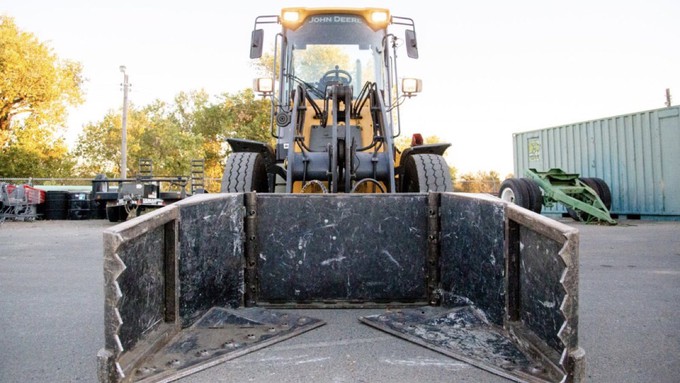
Sacramento crews now picking up street piles

The Claw is a popular member of the City of Sacramento street crew. Courtesy City of Sacramento
It’s leaf season and, in Sacramento, that means it’s Claw season, too.
And after Thursday’s storm, many Sacramento neighborhoods could use a visit – leaves are everywhere!
Now through the end of January, The Claws – Sacramento’s specialized fleet of articulated tractors – will be making the rounds, scooping up leaf piles on city streets. Jan. 23 is the last day that residents can set out piles for pick-up.
On average, each household will get about seven visits from The Claw, estimate city officials. Residents can find out when The Claw will be in their neighborhood with The Claw calendar, available on Sacramento’s official Leaf Season webpage, www.SacLeafSmart.org.
In all, The Claw crews expect to pick up about 20,000 tons of material this season. Besides leaves, branches and other pruning debris are also accepted. (No tree stumps allowed.)
Although organic food waste (along with leaves and yard debris) now goes in the green-waste container, don’t dump food waste or paper into leaf piles. The Claw won’t pick them up.
Here are more leaf season tips:
* Leaf piles can be no bigger than 4 by 4 by 9 feet (and just one per household). Make sure there is space between the pile and the curb so water can flow down the gutter. Also, place the pile at least 6 feet away from cars, boats, basketball hoops or other obstructions. The Claw needs room to maneuver.
* Don’t put plastic bags in street piles (including bags full of leaves). And don’t contaminate the leaf pile with trash or dog poop (a common problem).
* During leaf season, the City of Sacramento continues to pick up green-waste containers. Fill those first before piling leaves in the street, advises the recycling and solid waste department. The containers will get picked up 13 times during leaf season.
For more information: SacLeafSmart.org.
-- Debbie ArringtonComments
0 comments have been posted.Sacramento Digs Gardening to your inbox.
Food in My Back Yard Series
April 1: Don't be fooled by these garden myths
March 25: Fertilizer tips: How to 'feed' your vegetables for healthy growth
March 18: Time to give vegetable seedlings some more space
March 11: Ways to win the fight against weeds
March 4: Potatoes from the garden
Feb. 25: Plant a fruit tree now -- for later
Feb. 18: How to squeeze more food into less space
Feb. 11: When to plant? Consider staggering your transplants
Feb. 4: Starting in seed starting
Sites We Like
Garden Checklist for week of March 30
Your garden doesn’t mind April showers. Get busy now to enjoy those future flowers.
* Get ready to swing into action in the vegetable garden. As nights warm up over 50 degrees, start setting out tomato, pepper and eggplant transplants.
* From seed, plant beans, beets, cantaloupes, carrots, corn, cucumbers, melons, pumpkins, radishes and squash. (Soak beet seeds overnight in water for better germination,)
* Plant onion sets.
* In the flower garden, plant seeds for asters, cosmos, celosia, marigolds, salvia, sunflowers and zinnias.
* Transplant petunias, zinnias, geraniums and other summer bloomers.
* Plant perennials and dahlia tubers for summer bloom.
* Transplant lettuce and cabbage seedlings.
* April is the last chance to plant citrus trees such as dwarf orange, lemon and kumquat. These trees also look good in landscaping and provide fresh fruit in winter.
* Smell orange blossoms? Feed citrus trees with a low dose of balanced fertilizer (such as 10-10-10) during bloom to help set fruit. Keep an eye out for ants.
* Apply slow-release fertilizer to the lawn.